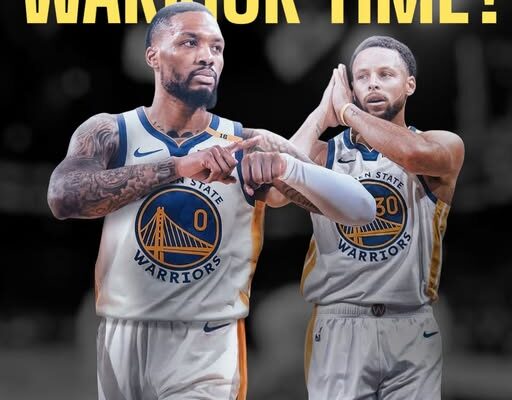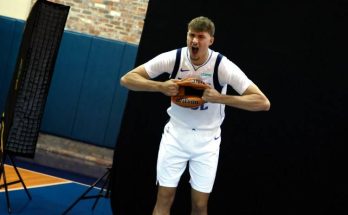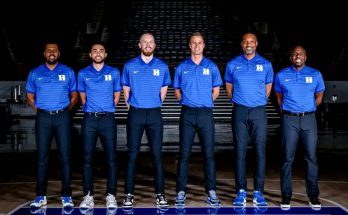Damian Lillard’s journey through NBA free agency in the summer of 2025 has taken the basketball world by surprise. Few could have predicted that the nine-time All-Star, who joined the Milwaukee Bucks in 2023 in a high-profile trade intended to create a superstar duo with Giannis Antetokounmpo, would find himself suddenly and unexpectedly available on the open market at the age of 35. Yet that is precisely what has unfolded, transforming Lillard’s professional trajectory and sparking an immediate and intense wave of interest from several NBA contenders—most notably the Golden State Warriors, whose Bay Area roots align closely with Lillard’s own North Oakland upbringing.
The catalyst for this seismic shift was twofold: injuries and cap strategy. Lillard, who averaged an impressive 24.9 points, 7.1 assists, and 4.7 rebounds over 58 games in the 2024–25 season, suffered a torn Achilles in Game 4 of the Bucks’ early playoff exit against the Indiana Pacers—a brutal injury that typically sidelines players for at least an entire season, if not longer. In response, the Bucks executed a stunning front-office maneuver: they waived and “stretched” Lillard’s remaining \$113 million contract over five years, freeing up significant cap space to sign center Myles Turner to a four-year, \$107 million deal.
The ramifications were immediate and sweeping. Stretching Lillard’s contract meant the Bucks would pay him roughly \$22.5 million annually for five years, regardless of whether he played. More importantly, it allowed Lillard to become an unrestricted free agent—free, for the first time in his career, to choose his own destination without restrictions. According to The Athletic, “Lillard received calls from several contending teams shortly after the news of his release… the Golden State Warriors, Boston Celtics and Los Angeles Lakers… among those eager to close a deal as soon as possible”.
Remarkably, Lillard’s reaction to the move was buoyant. Sources close to the player, including Sam Amick of The Athletic, described him as “elated” at the newfound autonomy, noting that he could sign with any team—potentially even for a vet-minimum deal—while still collecting his Bucks salary. This unusual position means Lillard can prioritize team fit and family needs over immediate finances, even reconsidering whether to sit out the 2025–26 season entirely to focus on rehab before resuming his career in 2026–27.
Amid the flurry of team interest, three franchises have emerged as clear frontrunners: the Lakers, the Celtics, and the Warriors. The Lakers and Celtics, both maintaining championship aspirations and capable backcourt stability, see Lillard as an affordable way to bolster their postseason chances upon his return ([lastwordonsports.com][5]). Boston, in particular, has been linked to a mutual interest in signing Lillard, and his existing friendship and on-court chemistry with Jayson Tatum—whom he played alongside for Team USA—could lay the groundwork for a powerful late-career tandem .
Still, for Lillard, the Bay Area remains a uniquely compelling option, and that has thrown the Warriors into exceptional light. Golden State’s interest aligns not only with strategic ends but also with deep personal resonance. A lifelong Bay Area native who grew up in Oakland, Lillard would be returning home, playing near family and friends in a supportive environment that fueled his early basketball journey . NBC Sports Bay Area reported that the Warriors had reached out to Lillard immediately after the news of his release, per Marc Spears, and emphasized that he was “ecstatic” at the prospect .
From a strategic standpoint, Golden State could benefit significantly from adding Lillard—even if he sits out the 2025–26 season to rehab. His elite shooting, veteran leadership, and playoff experience would complement the core of Stephen Curry, Draymond Green, and Jimmy Butler. It’s also worth noting that the Warriors, under their financial capacity, can afford to bring him in without jeopardizing long-term flexibility; Lillard’s income remains anchored to Milwaukee regardless of where he plays next .
The underlying assumption for most of these suitors is that Lillard will not play in 2025–26. Yet there has been speculation that he could return as early as the 2026 All‑Star break—a tantalizing possibility heard around the league . Even with such uncertainty, the ability to sign Lillard and allow him to rehabi—potentially relegated to a bench or mentorship role in the short term—offers a low-risk, high-reward scenario for contenders. Teams like Boston, especially under the tax apron, view this as an opportunity: sign a future hall-of-famer at a bargain and invest in championship upside years down the road .
For Lillard himself, the decision-making framework now looks different. Money is no longer the top driver. He’s insured and will be paid regardless. What matters are context and intent: where he wants to rebuild his body, how he sees his leadership role in the locker room, whether he wants to chase a ring immediately—or quietly—rehab with an eye toward a late-career charge. His Instagram in the immediate aftermath carried a Zen-like quote: *“A man in tune with himself don’t move fast… he moves correct.”* It hinted at a patient, calculated process.
This transition also underscores the modern NBA’s evolving free-agency model. In recent years, teams have leaned heavily into two-way deals, vet-minimum bargains, and pay-for-potential structures, betting on upside with controlled financial exposure. Lillard’s situation has viralized that approach: a guaranteed contract, a major injury, and the freedom to choose a team and rehab under its system. This rare blend of security and agency is reshaping expectations—particularly for veterans on the wrong side of 30.
Golden State’s window is perhaps even narrower than those of the Celtics or Lakers. Curry, now 37, may have only a few high-level seasons left. Bringing in Lillard would reinforce their contention band for another couple of years—even if Lillard’s physical peak lies behind him. But his playmaking, clutch weapons, and off-ball gravity could ease pressure on Curry and opposing defenses in key moments.
There’s also the narrative allure. Imagine Lillard in a Warriors uniform, returning home to anchor the pick-and-roll with Curry; imagine him guiding a young backcourt trio while vying for one more title. For Bay Area fans, it would feel like destiny. Crucially, the Warriors have already been linked to this possibility in multiple reports from NBC Sports Bay Area and SI, both citing Lillard’s location and his willingness to consider bringing his rehab to the Bay .
That’s not to say Golden State has a clear path forward. They must navigate Jonathan Kuminga’s restricted free agency and guard against tax violations. They must balance roster continuity with the aggressive addition of a high-profile barb like Lillard. And they must weigh the risk that he may not play at all in 2025–26—or may return at diminished capacity. These factors give Boston or LA room to outmaneuver them with flexible, immediate-fit offers. But Golden State’s emotional and logistical advantages keep them firmly in the picture.
For the Lakers, a potential pairing of Lillard and LeBron James reunites two of the era’s most electrifying guards in L.A. with a deep, playoff-caliber bench behind them. It’s a splash move that would signal ambition and nostalgia in equal measure. Meanwhile, Boston offers the promise of pairing Lillard with Jayson Tatum and Jaylen Brown in a system built for spacing and pace—a configuration that could maximize his strengths once healthy.
As of early July, though, the Warriors are loud and early, confirmed to have reached out, and are seriously weighing whether to make a run at a hometown icon . League insiders suggest Lillard can afford to let teams come to him, choosing carefully rather than hurriedly . His affiliation with both Portland (his draft home) and Milwaukee is now overshadowed by this fresh opportunity: to become a free man in free agency, and possibly to rewrite the final chapter of his career on his own terms.
This saga isn’t just about one player’s contract; it’s about the shifting power dynamics between athletes and franchises, the value of personal and physical fit over dollars, and the influence of geography on career decisions. If what happens next is a return to the Bay, it may mark one of the most resonant offseason moves in recent memory—and a dream fulfilled for a hometown hero.
Going forward, all eyes will be on Lillard’s rehab progress and his timetable for signing. Will he ink a deal before the season starts, or wait until the All‑Star break? Will he play the entire season through Houston, Boston, L.A., or the Warriors’ development system? Or will he defer until fully healed, with the title window pivoting to 2026–27? Each choice writes a different plot line for his legacy.
Whatever unfolds, one thing is clear: in mid‑2025, a sudden act of cap ingenuity by Milwaukee has rippled throughout the league. It has created a marketplace where price is not the point, but promise and place are. And at its center stands Damian Lillard—repositioned, energized, and open to the possibility of rewriting the final act on his terms.



